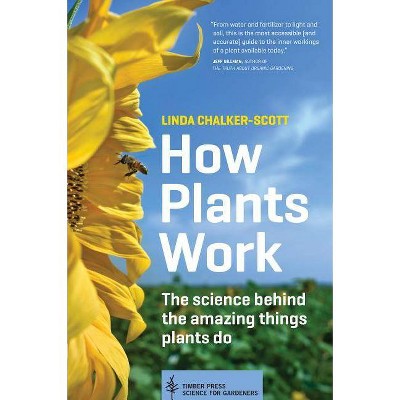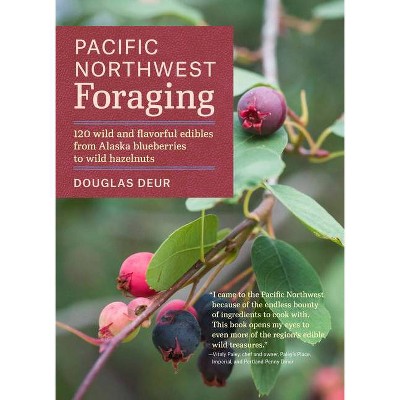How Plants Work - by Stephen Blackmore (Hardcover)

Similar Products
Products of same category from the store
AllProduct info
<p/><br></br><p><b> About the Book </b></p></br></br>"All the plants around us today are descended from simple algae that emerged more than 500 million years ago. While new plant species are still being discovered, it is thought there are around 400,000 species in existence. From towering redwood trees and diminutive mosses to plants that have stinging hairs and poisons, the diverse range of plant life is extraordinary. How Plants Work is a fascinating inquiry into, and celebration of, the complex plant kingdom. With an extended introduction explaining the basics of plant morphology--the study of plant structures and their functions--this book moves beyond mere classification and anatomy by emphasizing the relationship between a plant and its environment. It provides evolutionary context drawn from the fossil record and information about the habitats in which species evolved, and argues for the major influence of predation on plant form. Each section of the book focuses on a specific part of the plant--such as roots, stems and trunks, leaves, cones and flowers, and seeds and fruits--and how these manifest in distinct species, climates, and regions. The conclusion examines the ways humans rely on plant life and have harnessed their capacity for adaptation through selection and domestication."--Jacket.<p/><br></br><p><b> Book Synopsis </b></p></br></br><p><b>A large-format, heavily illustrated look at the wide adaptability and rich diversity of the plant kingdom</b> <p/>All the plants around us today are descended from simple algae that emerged more than 500 million years ago. While new plant species are still being discovered, it is thought that there are around 400,000 species in existence. From towering redwood trees and diminutive mosses to plants that have stinging hairs and poisons, the diverse range of plant life is extraordinary. <i>How Plants Work</i> is a fascinating inquiry into, and celebration of, the complex plant kingdom. <p/>With an extended introduction explaining the basics of plant morphology--the study of plant structures and their functions--this book moves beyond mere classification and anatomy by emphasizing the relationship between a plant and its environment. It provides evolutionary context drawn from the fossil record and information about the habitats in which species evolved and argues for the major influence of predation on plant form. Each section of the book focuses on a specific part of the plant--such as roots, stems and trunks, leaves, cones and flowers, and seeds and fruits--and how these manifest in distinct species, climates, and regions. The conclusion examines the ways humans rely on plant life and have harnessed their capacity for adaptation through selection and domestication. <p/>Abundantly illustrated with 400 color images documenting a wide range of examples, <i>How Plants Work</i> is a highly informative account about an integral part of our natural world.<br></p><ul><li>400 color photos and meticulously drawn figures<br></li><li>Scanning electron microscopy images offer close-up views of plant structures<br></li><li>Diverse examples from around the world<br></li><li>Plant morphology in an evolutionary context<br></li></ul><p/><br></br><p><b> Review Quotes </b></p></br></br><br>Every page includes a photo or a few images, all shot by brilliant photographers that capture engaging angles and are a delight to browse.-- "Pennsylvania Literary Journal"<br><br>If you garden, photograph flowers, or simply pay attention to non-feathered things on your birding walks, [<i>How Plants Work</i>] is a revealing book. The life of plants is far more complicated than a casual stroll through garden or woodlot might show.<b>---Jim Williams, <i>StarTribune Wingnut blog</i></b><br><br>This book is exceedingly well written, precise, cogent and filled with essential information. A reader without any prior knowledge of plant science will derive satisfaction, acquire knowledge and become a more informed citizen. Anyone with even a passing familiarity with plant science will have his/her skills and knowledge updated and enhanced.<b>---David Gascoigne, <i>Travels with Birds</i></b><br><p/><br></br><p><b> About the Author </b></p></br></br><b>Stephen Blackmore </b>is a botanist and conservationist. His books include<i> </i><i>Green Universe</i><i> </i>and <i>Plant Conservation Science and Practice</i>. He was the 15th Regius Keeper of the Royal Botanic Garden Edinburgh and was appointed Her Majesty's Botanist in Scotland in 2010. He is chairman of Botanic Gardens Conservation International and the Darwin Expert Committee.
Price History
Cheapest price in the interval: 24.49 on November 8, 2021
Most expensive price in the interval: 24.49 on December 20, 2021
Price Archive shows prices from various stores, lets you see history and find the cheapest. There is no actual sale on the website. For all support, inquiry and suggestion messages communication@pricearchive.us




















